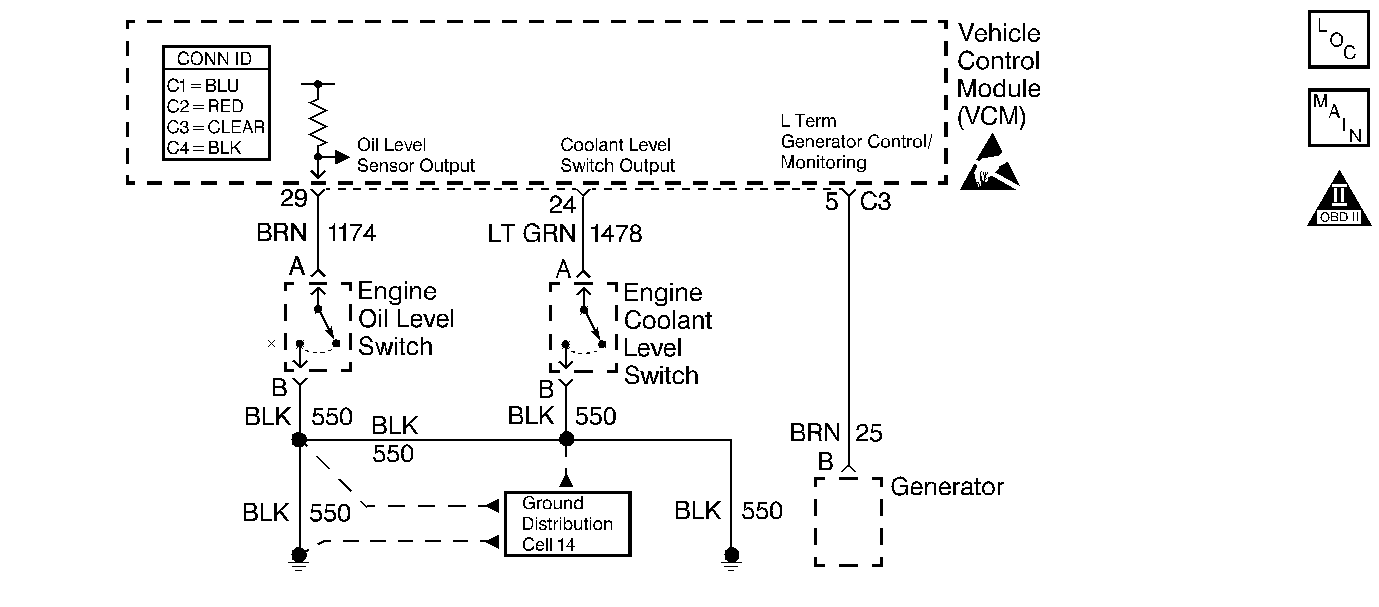
Circuit Description
This test checks for a low engine coolant condition. The pressurized coolant bottle is equipped with a level switch which opens when coolant level is low. The VCM monitors the state of this switch and measures the time that the switch is open. If the switch is open for longer than a calculated period of time, the VCM signals the IPC via the data link to turn on the LOW COOLANT message.
The period of time before a low coolant condition is recognized is based on vehicle speed and acceleration. The higher vehicle speed and acceleration, the longer the time before a low coolant condition will be recognized. Low coolant level message is displayed on the IPC for the entire ignition cycle.
Diagnostic Aids
The Engine coolant level switch shares a common ground. An intermittent at any of the common ground and/or component's connections could possibly cause the LOW COOLANT message to remain ON even though the coolant level is at its proper level.
If the customer complaint is that the coolant level is low, but there is no LOW COOLANT message displayed, then check for a stuck switch.
In order to clear the LOW COOLANT message after a repair, remove the ignition key for 10 seconds. Turning the ignition OFF then ON will not clear the message.
An intermittent may be caused by any of the following conditions:
| • | A poor connection |
| • | Rubbed through wire insulation |
| • | A broken wire inside the insulation |
Thoroughly check any circuitry that is suspected of causing the intermittent complaint. Refer to Intermittents and Poor Connections Diagnosis in Wiring Systems.
If a repair is necessary, refer to Wiring Repairs or Connector Repairs in Wiring Systems.
Test Description
Number(s) below refer to the step number(s) on the Diagnostic Table.
-
The voltage should be near battery voltage.
-
The Engine Coolant Level Switch is replaced as a complete unit with the Surge Tank.
Step | Action | Value(s) | Yes | No |
|---|---|---|---|---|
1 | Did you perform the Powertrain On-Board Diagnostic (OBD) System Check ? | -- | ||
2 |
Caution: Do not remove the pressure cap from the high fill reservoir while the engine is at normal operating temperature. An unexpected release of hot engine coolant may result in severe burns. Physically check engine coolant level in surge tank. Did you find a problem? | -- | ||
3 |
Does the Message Center display the LOW COOLANT message? | -- | ||
Is the voltage above the specified value? | 11 V | |||
5 | Probe the switch ground with a test lamp connected to B+. Did the test lamp turn ON? | -- | ||
6 |
Did the test lamp turn ON? | -- | ||
7 |
Did the test lamp turn ON? | -- | ||
8 | Check for an improper harness connector connection at the VCM and Coolant Sensor. Refer to Diagnostic Aids. Did you find a problem? | -- | ||
9 | Check for an improperly operating Message Center display. Refer to Instrument Cluster System Check in Instrument Panel, Gauges, and Console. Did you find a problem? | -- | ||
10 | Fill the surge tank to the proper level. Refer to Loss of Coolant in Engine Cooling. Is the action complete? | -- | -- | |
11 |
Is the action complete? | -- | -- | |
12 |
Is the action complete? | -- | -- | |
Replace the Engine Coolant Level Switch. Refer to Radiator Surge Tank Replacement in Engine Cooling. Is the action complete? | -- | -- | ||
14 |
Is the action complete? | -- | -- | |
15 | Operate the vehicle under the conditions that the original problem was encountered. Is the problem still present? | -- | System OK |
